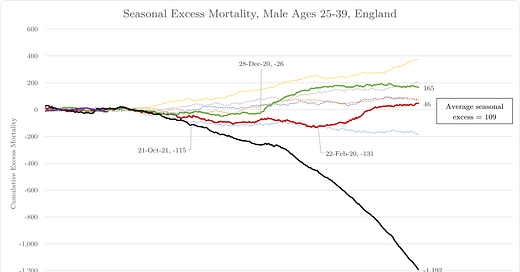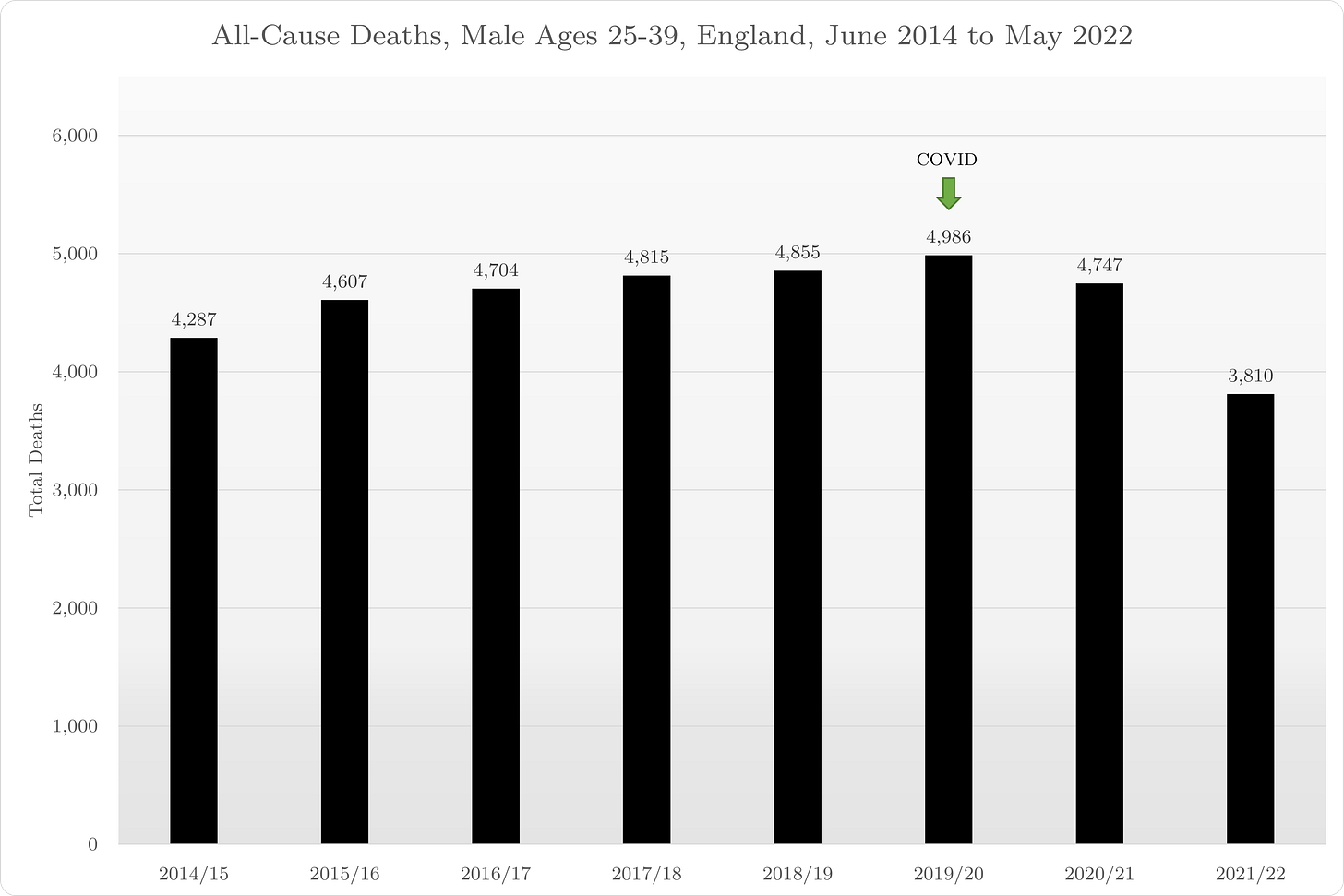When did COVID really first hit the UK?
Odd signals from deaths, males and females 25 to 39 years old.
I had a look at deaths of 25 to 39 year old men and women in England between 2014 and 2022 to see if there was anything insightful. Sure enough, there was plenty.
Starting with the men, it is apparent that usually there isn’t much by way of variability in season or pattern. In fact, this makes 2019/20 (red line) stand out as the only year up to that point, since June 2014, with a marked inflection during the period.
Although it occurs during the spring when the COVID pandemic was announced, the deaths start on 22nd Feb 20, a whole month before they really take off for the older age groups. If this is COVID, it would put the viral outbreak somewhere towards the end of January which is consistent with my other analyses.
Also atypically, we see deaths surge on 28th Dec 20 (green line), just 3 weeks after the mRNA experiment begins, despite having absolutely no excess death whatsoever in this age/sex group up until this point in the 2020/21 season.
Nevertheless, both years finish below seasons 2016/17 and particularly 2017/18, which was a very bad flu season for young men in England.
COVID year was the worst overall in terms of mortality for the full 12 months but in line with the prevailing, upwards trend. Impossible to say how 2021/22 is going to pan out as it looks like reports are delayed since 3rd week of October 2021, with at least 1,300 still with the coroner by my reckoning1.
But, it’s with the women where things become really startling.
Unlike the males, the female deaths show distinct seasonality with typically a single inflection some time after October. 2019/20 (red line), the year of the COVID, had a very early inflection, occurring in the 3rd week of October. It’s not possible to determine if that was COVID or not. Probably not. Probably whatever flu was dominant at the time.
But look at the inflection on 13th Feb 2020. That is uncharacteristically late in the season but much earlier than the official start of COVID death counting. More than a week before the men started dying, assuming the same infection-to-death period, this would put viral outbreak closer to mid-Jan.
What’s the implication of this? It shows that the virus was well-established in the country by the time strict measures were implemented to try and contain transmission. If the empirical work had been done properly, the futile but damaging measures could have been avoided.
It also means it must have been killing older folk at that time but not at remarkable levels, making you wonder even more why the deaths went off the scale post-lockdown and not before?
Again, we see the staggering impact on 28th Dec 2020 (green line), with both years (COVID and mRNA experiment) ending way outside the normal excess deaths range.
What gets me though is the 3-week period between 24th Aug and 11th Sept 2021 (black line) where 44 young women died unexpectedly (and not just a few weeks earlier than they might have done by the looks of things). Is there something really peculiar about that time window that ought to have been investigated or do we simply run into the start of the coroner delays?
If it’s the latter, there may be something truly awful to report when the data finally becomes available.
And to think, Jonathan Engler and I had to do an hour-long video back in 2020, explaining and justifying why deaths data by date of registration was useless in spite of the fact that all the ONS reports were done this way. 🤡🌏







The census here in America is reporting 16 million working age Americans with long-covid issues, 4 million of whom are unable to work, and zero Americans with vaccine injuries. So I am sure whatever truly awful thing found will have absolutely nothing to do with the vaccines.
The virus was here (Scotland, Highlands and lowlands) in December 2019, I know many dozens of people who had it then and over Christmas. It carried on into January. A friend's long planned 50th birthday party was almost cancelled because many who had been invited were not well enough to attend. GPs called it 'mystery flu'. I know someone who was very ill in November, he was in hospital 3 times (with pneumonia symptoms) and they tested him for everything but could not identify what it was. It was a very bad flu for most people, but no worse than that. My wife was very ill for 2-3 weeks, the cough, could barely breathe, I thought was pneumonia. Kids got it lost sense of taste and smell, and had fever. I just had a sore throat, one evening, and was fine the next day. So I must have had t cell immunity, from a previous coronavirus.